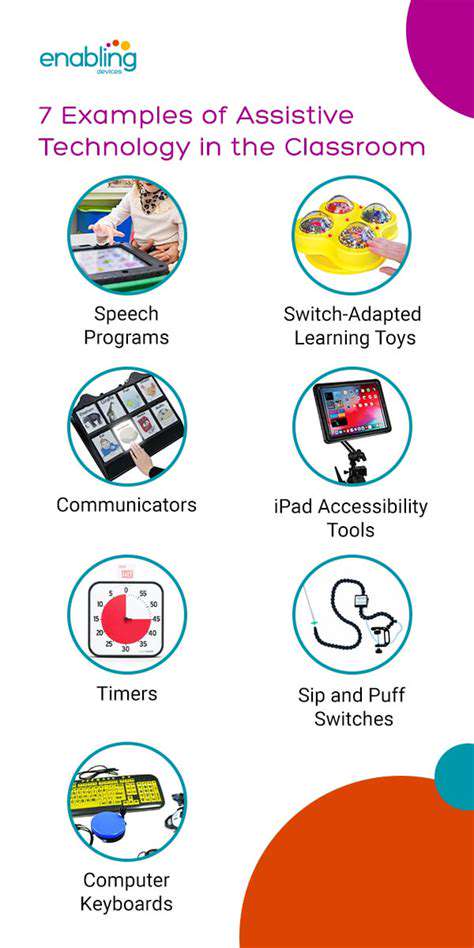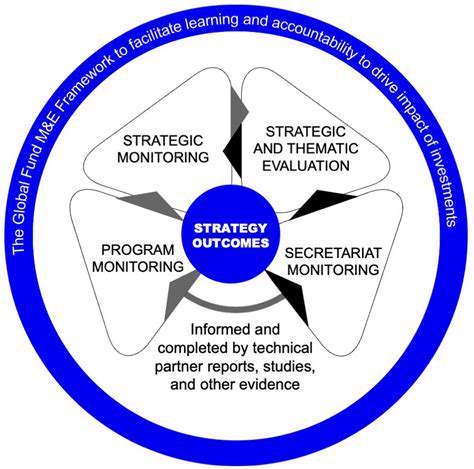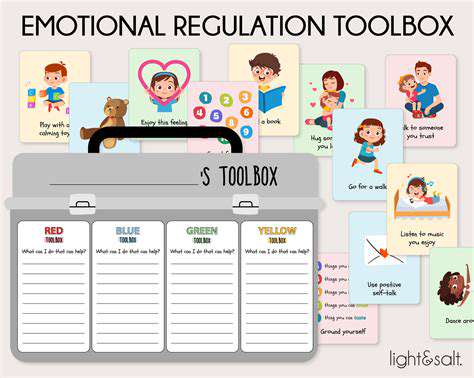Toddler Tantrums Decoded: Understanding and Responding to Emotional Outbursts
Understanding the Underlying Needs
Toddler tantrums often stem from a child's inability to effectively communicate their needs and desires. They're experiencing a flood of emotions—frustration, hunger, tiredness, or even a simple desire for a specific toy—but lack the vocabulary to articulate them. Recognizing this underlying need is crucial to understanding and responding appropriately. This understanding helps parents avoid escalating the situation by simply focusing on addressing the root cause instead of the outburst.
This developmental stage is characterized by rapid growth and change, which can lead to a wide range of emotions and behaviors. Understanding that these tantrums are often a sign of a need, rather than a deliberate act of defiance, is crucial for parents to respond constructively.
The Role of Exhaustion and Hunger
Toddlers, with their boundless energy and constant exploration, often push themselves to the limit. A tired toddler is a cranky toddler. They may not be able to articulate their fatigue, and a simple nap or quiet playtime could make a world of difference in their behavior. Furthermore, hunger plays a significant role in temper tantrums. A rumbling tummy can quickly escalate a minor frustration into a full-blown meltdown.
It's vital for parents to recognize the signs of fatigue and hunger. A consistent routine for meals and rest can significantly reduce the frequency of these episodes.
Frustration with Limitations and Expectations
Toddlers are developing a sense of self and autonomy. They are constantly testing boundaries and exploring their environment. When faced with limitations or expectations they don't understand or agree with, frustration can build and manifest as a tantrum. This could be anything from being told no to not being able to reach something they desire.
Helping toddlers understand and accept limitations is a key aspect of navigating these challenging moments. This involves explaining the why behind rules and expectations in a way they can grasp.
Sensory Overload and Over-Stimulation
The world can be a very overwhelming place for a toddler. Loud noises, bright lights, and busy environments can easily overwhelm their senses, leading to meltdowns. A child experiencing sensory overload may exhibit signs of distress, such as covering their ears, rubbing their eyes, or becoming agitated. Understanding these signs can help parents intervene and create a calmer environment.
Lack of Attention and Interaction
Toddlers crave attention and interaction. If they feel neglected or ignored, their frustration can escalate into a tantrum. This could be the result of parents being preoccupied with other things or simply not giving them the attention they desire. Understanding this need for connection is crucial for managing toddler tantrums.
Engaging with your toddler in meaningful ways—through play, conversation, or simply holding them—can prevent tantrums caused by a lack of attention.
Developmental Stages and Milestones
Toddlerhood is a period of significant developmental change. New skills and abilities are being acquired, and frustration with not quite mastering something can lead to tantrums. Recognizing these developmental milestones and adjusting expectations accordingly can help parents navigate these challenging behaviors. A toddler who is struggling with a specific skill might need extra support and understanding.
Lack of Structure and Routine
Predictability and routine are very important to toddlers. Unpredictable schedules and a lack of structure can lead to anxiety and frustration, which can manifest as tantrums. Establishing a consistent routine for meals, sleep, and activities can greatly reduce the likelihood of meltdowns. A predictable environment can create a sense of security and reduce stress for young children.
Responding to Tantrums: Strategies for Effective Management

Understanding the Root Causes
Tantrums, while frustrating for everyone involved, often stem from underlying issues. Children, particularly those who are still developing their communication skills, might be overwhelmed by emotions they can't yet articulate. Recognizing these emotional triggers is the first step toward effective intervention. This could include hunger, tiredness, or a feeling of powerlessness in a particular situation.
Parents and caregivers should try to identify patterns in the child's behavior. Understanding what typically precedes a tantrum, whether it's a specific activity, a change in routine, or a certain social interaction, allows for proactive strategies to avoid potential triggers and manage the situation more effectively. For instance, if a child consistently has tantrums before nap time, perhaps adjusting the schedule or offering a calming activity beforehand could help.
Creating a Calming Environment
A calm environment is crucial in de-escalating a tantrum. Minimize distractions and create a space where the child can feel safe and secure. This might involve moving to a quiet corner, a designated 'calm-down' area, or simply finding a moment of quiet together.
Soft lighting, soothing music, or even a comforting blanket can significantly reduce the intensity of a tantrum. A calm environment allows the child to process their emotions and transition back to a more regulated state.
Active Listening and Validation
Even when a child is having a tantrum, it's essential to listen actively and validate their feelings. Acknowledge their emotions, even if you don't necessarily agree with their behavior. Phrases like, I can see you're really upset, or It sounds like you're feeling frustrated, can help the child feel understood and heard.
Setting Boundaries and Limits
While validating feelings is important, setting clear boundaries and limits is equally crucial. Consistency in these boundaries is key to helping the child understand expectations and develop self-regulation skills. This involves calmly and clearly explaining what behaviors are unacceptable and the consequences for engaging in those behaviors. Establishing these limits in a calm and reassuring way, even during a tantrum, helps the child understand expectations and limits.
Distraction Techniques
Sometimes, a simple distraction can be enough to redirect a child's attention away from their negative emotions. Offer an engaging activity, a favorite toy, or a change of scenery. This can be particularly effective when the tantrum is caused by a specific frustration or unmet need. For example, if a child is upset about not getting a specific toy, offering a similar alternative can help redirect their attention and diffuse the situation.
Seeking Professional Guidance
Dealing with persistent or severe tantrums can be challenging. If you're struggling to manage these behaviors effectively, don't hesitate to seek guidance from a pediatrician, a child psychologist, or other qualified professionals. Professional support can provide valuable insights into the specific needs of the child and tailored strategies for managing the situation. This support can ensure that the child receives the appropriate care and guidance to navigate these emotional challenges.
Seeking Professional Support: When to Reach Out
Recognizing the Signs of Overwhelm
Toddler tantrums can be incredibly frustrating for parents, but understanding the underlying reasons behind them is crucial for effective intervention. These outbursts often signal that a child is feeling overwhelmed by a situation they don't yet have the language or coping mechanisms to manage. Recognizing these signs, like excessive demands, unmet needs, or a sudden shift in environment, can help parents proactively address the triggers before a meltdown escalates.
Look for patterns in your child's behavior. Are tantrums more frequent during specific times of the day, like after naps or before bedtime? Are there particular activities or demands that seem to consistently provoke these reactions? Understanding these patterns can help you anticipate potential triggers and develop strategies for managing them.
Understanding the Underlying Needs
Toddlers are still developing their communication skills, and tantrums are often their way of expressing unmet needs. These needs can range from basic physical needs like hunger or tiredness to more complex emotional needs like the need for connection, security, or independence. Trying to understand what your child might be communicating through their behavior can greatly improve your ability to respond effectively.
Consider the environment surrounding the tantrum. Is there a lack of clear boundaries or expectations? Is the child feeling pressured to do something they don't want to do? By considering the context of the situation, you can gain valuable insights into the underlying needs driving the behavior.
Developing Effective Coping Strategies
Learning how to respond calmly and effectively to tantrums is vital. This isn't about ignoring the behavior, but rather about responding in a way that helps your child learn more constructive ways to manage their emotions. Creating a safe and supportive environment where your child feels heard and understood is paramount.
Distraction techniques, positive reinforcement, and setting clear boundaries can all be effective tools. However, consistently applying these strategies requires patience and persistence. Remember that every child is unique, so what works for one may not work for another. Experiment with different approaches to find what resonates best with your child.
Seeking Professional Guidance
While many tantrums can be managed effectively at home, some children may benefit from professional guidance. If tantrums are frequent, intense, or significantly impacting your family's daily life, consider seeking support from a pediatrician, child psychologist, or therapist. These professionals can provide valuable insights into your child's development and offer tailored strategies for managing challenging behaviors.
A professional can help you identify potential underlying issues, such as developmental delays or anxiety, and offer guidance on creating a supportive environment. They can also offer strategies to help you manage your own stress and frustration related to these behaviors.
Building a Supportive Network
Parenting a toddler can be challenging, and it's important to remember that you are not alone. Building a supportive network of family, friends, or other parents facing similar challenges can provide invaluable emotional support and practical advice. Sharing experiences and strategies can help you feel less isolated and more equipped to navigate the ups and downs of toddlerhood.
Connecting with other parents through playgroups, support groups, or online communities can provide a sense of shared understanding and practical tips. This network can offer emotional support, practical advice, and a sense of community during this often demanding stage of parenting.











